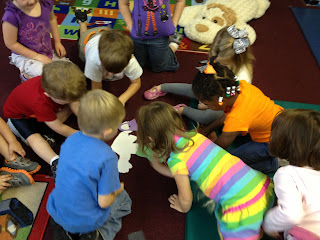 I'm always looking for ways to bring some reading fun to the holiday season. Things can get so busy, so working some ideas for encouraging reading into the holiday plan can make sure you don't get too busy for reading.
I'm always looking for ways to bring some reading fun to the holiday season. Things can get so busy, so working some ideas for encouraging reading into the holiday plan can make sure you don't get too busy for reading.Here are some ideas for a holly, jolly, reading Christmas:
1. Check the events going on at your local library. Weekly story times often take a hiatus this time of year, but instead there's usually lots of holiday programs and activities going on.
2. While attending a special holiday event at the library, go on a hunt for some great Christmas books. Some libraries will mark the spines of their books to make special titles (like holiday titles) easier to find.
3. Do a reading advent calendar, like this one here. Have you seen this idea? Wrap 25 Christmas picture books (they can be ones you already own), then allow your child to unwrap one each day and read it together as you countdown to Christmas.
4. Make books a part of your gift-giving tradition. Unwrapping a cool new book or two on Christmas morning attaches the right connotation to books - they are something to be enjoyed! Some families make gifting a new pair of pajamas a Christmas Eve tradition; perhaps pairing a new book with their snuggly pajamas could become part of the tradition as well. Think about subjects your child is especially interested in, or books in a series they might be specifically wanting. We might be gifting some fun magazine subscriptions in our house this year!
5. Start a tradition of adding a new Christmas book to your family library every season. Make a special trip to the bookstore together to pick it out. Maybe get some hot cocoa while you're at it, and make a whole date of it!
6. If you do Elf on the Shelf, incorporate some reading fun into your elf's repertoire of tricks. Perhaps he will get caught reading the kids' Christmas books? Or perhaps he will get caught reading to some of your kid's toys, like in this photo?
7. Gift some fun items to your child that help encourage reading. We're giving neat reading lights to our kids to encourage them to stay up late in bed with a book.
Another idea is the fun book timers for keeping track of their reading time (they are book marks that can be stored right in the book your child is reading).
How about a kit for creating their own books?
Or a fun bag for toting books to and from the library?
8. Give books as gifts to others with your child. How about for their teacher? Friends? Family? Ask for their input and help in selecting the right book for the people on your list this Christmas.
9. Make some festive sugar cookies with alphabet cookie cutters. Spell out festive words like "joy" and "merry" and then box them up and gift them to friends and family. Isn't this pretty? You could also make fun alphabet ornaments and gift tags using a variety of different supplies and things. Get creative!
How do you encourage reading and literacy during the holidays?

















































